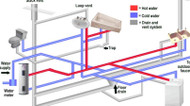Plumbing Basics
Sep 26th 2018
Plumbing follows the basic laws of nature - gravity, pressure, water seeking its own level. Knowing this can help you understand its mystery and make tons of fixes to your plumbing system. You'll save time, trouble and money!
The plumbing system in your home is composed of 2 seperate subsystems. One brings fresh water in, and the other takes wastewater out. The water that comes into your home is under pressure. It enters your home under enough pressure to allow it to travel upstairs, around corners, or wherever else it is needed. As water comes into your home, it passes through a meter that registers the amount you use. The main shutoff, or stop, valve is typically located close to the meter. In a plumbing emergency, it is vital that you quickly close that shutoff valve. Otherwise, when a pipe bursts, it can flood your entire home. If the emergency is confined to a sink, tub, or toilet, however, you may not want to turn off the entire home. Therefore, most fixtures have indivdual stop valves.
Water from the main supply is immediately ready for cold water needs. the hot water supply, however, requires another step. One pipe carries water from the cold water system to your hot water heater. From the heater, a hot water pipe carries hot water to all your homes fixtures like bath tub, sinks and showers. A thermostat on the hot water heater maintains the temperature you select for your hot water to be when it is used. A normal setting for this is between 140 degrees F and 160 degrees F, but 120 degrees F is usually adequate and saves money.
Wheather your home is on a sewer or septic system, the systems within your home are essentially the same. Drainage systems do not depend on pressure, as supply systems do. Instead, waste matter leaves your home because the drainage pipes all pitch, or angle, downward. Gravity pulls the wasye along. While the system sounds simple, there is more to it, including vents, traps, and clean outs. The vents sticking up from the roof of your home allowing air to enter the drainpipes. If there were no air supply coming from the vents, wastewater would not flow out properly and the water in the traps would need to be siphoned away.
This is just some basic knowledge that will help you to understand how basic plumbing systems work in your home.


